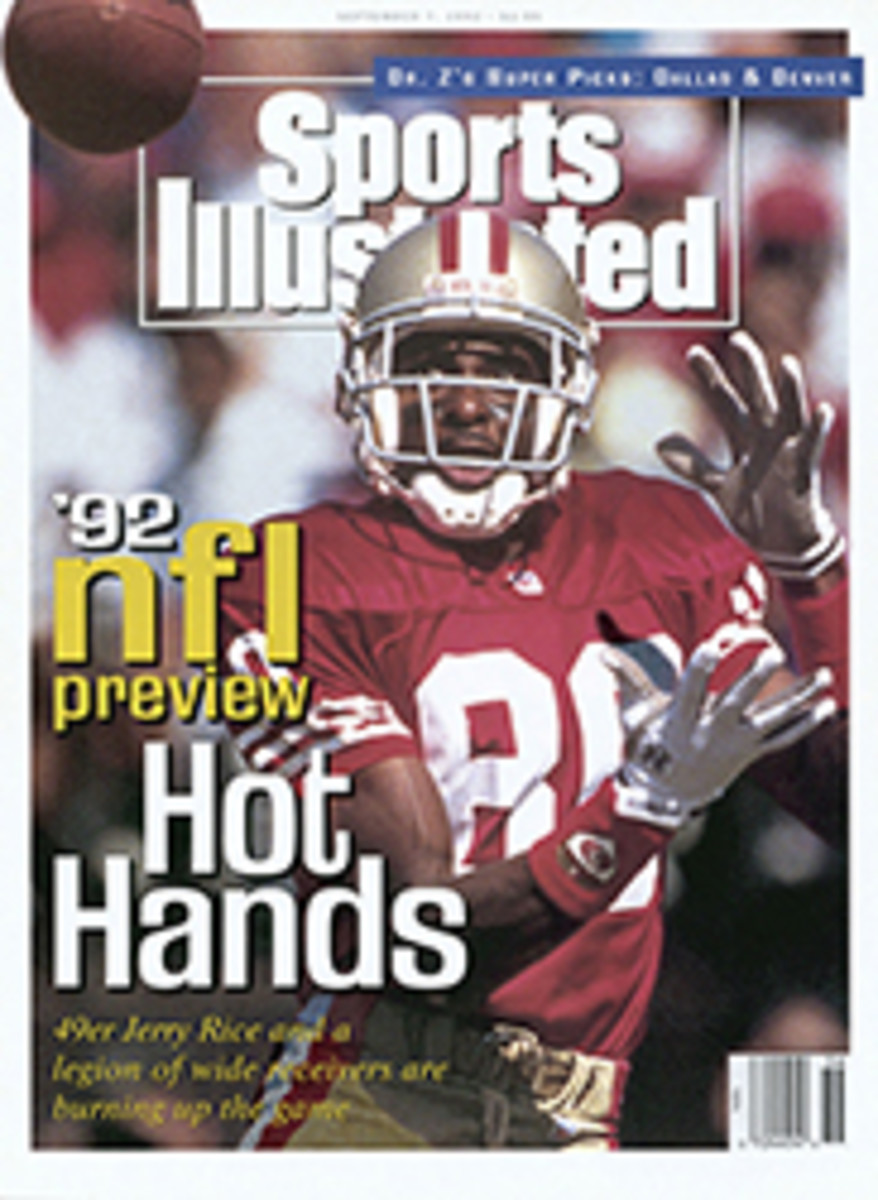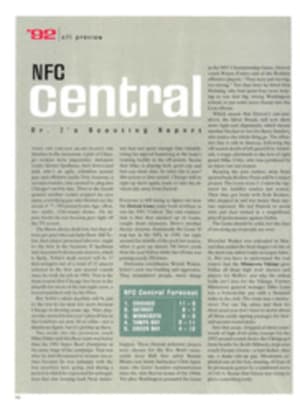
War Stories
They were born four months apart in 1940, and they played their high school football within 100 miles of each other in Mississippi, Lance Alworth in Brookhaven, Willie Brown in Yazoo City. A decade later they were defining an era of professional football.
Alworth, with his burst of speed and his leaping catches, as explosive as the lightning bolt on the side of his San Diego Charger helmet, was the American Football League's showpiece, its deep threat. With his baby face and sandy crew cut—Bambi, they nicknamed him—he looked 16 years old, but the All-America out of Arkansas was instant box office for a new league that was establishing itself through the pass. He put together seven straight 1,000-yard receiving seasons (1963-69), a feat that has never been duplicated in pro football. In 1965 he gained 1,602 yards, second-best of all time, and averaged 23.2 yards a catch.
Brown, a linebacker for a Grambling team that sent nine players into the pros, struggled after signing as a free agent with the Houston Oilers, who converted him to defensive back and then cut him before the 1963 season began. But he was picked up by the Denver Broncos, became a starter and then was traded to the Oakland Raiders four seasons later. Brown became the premier cornerback at a time when AFL secondaries were trying desperately to equalize the offense-defense mismatch. Oversized at 215 pounds, gifted with a burst of speed almost as explosive as Alworth's, he lasted 16 years and made the Hall of Fame as soon as he was eligible. So did Alworth, whose career was five seasons shorter.
They faced each other 24 times, counting preseason games. Their battles became classics. Brown was the master of the bump-and-run, Alworth the ultimate escape artist. In July they met again at Long Beach State, where Brown has taught in the phys-ed department since the school's football team, which he coached, was scrapped for budgetary reasons after last season. Alworth, a partner in a company that builds and sells mini-storage facilities nationwide, made the hour-and-a-half drive north from his home in Del Mar, Calif.
They were brought together to talk football, to trade old war stories and to take a look at what their slice of the game had become. "How many passes would you catch today," I asked Alworth, "in this era of no bumping downfield and of quarterbacks throwing 30 to 40 passes a game?"
"As many as they would throw to me," he said, flashing the little boy's grin that had earned him his nickname. And I remembered a conversation of 25 years ago, when I told Alworth something that New York Jet wideout George Sauer had said, that he could catch the little Joe Namath square-outs all day, 20 of them maybe, except that his body couldn't take it, the cornerbacks would tear his ribs apart. "Gee," Alworth had said, wistfully, "I wish they'd throw me 20 passes a game."
"Hunger, he always had that great hunger for the ball," Brown said. "Shoot, in today's system, with all those zone coverages, Lance would have over 100 catches a year easy."
"Yeah, this era would be fun," Alworth said. "Of course it might not be fun for the defensive backs. One thing I do notice is that the interference rules are so much tighter now. They seem to call it every time a guy turns around. I remember I was always yelling at the officials, 'Pass interference! Pass interference! Call it!' And the official would tell me, 'If I call it on him I've got to call it on you, too.' "
"You were known to occasionally push off," Brown said.
"Hell, I had to do something," Alworth said. "The problem was, you'd get away from the first bump and then the guy would hold you. The best thing that ever happened to me was when the Chargers got tear-away jerseys. Seems I was always running through a forest of hands. I felt like yelling, 'Hey, let me out of here!' But even with that, I can't remember our guys dropping as many balls as they do now.
"Did we drop that many passes?" he asked Brown.
"No, hell no," Brown said.
"I mean, we dropped our share," Alworth said, "but not as many as today. We didn't get thrown to that much, so we had to make do with what we got."
The rule changes in 1978 that limited defensive backs to one bump of the receiver within five yards of the line of scrimmage dealt a severe blow to the big, physical cornerback.
"You would escape Willie's first bump," Alworth said, "and you thought you were free, and wham, you'd get it again—from where you didn't expect it. It was always something to be concerned about, always something to get you off balance. Now even that first bump seems like a dying art. You don't see receivers knocked off balance the way they used to be. It's not really taught in the colleges or the pros."
"There are guys who can still do it, but not many," Brown said. "Albert Lewis of the Chiefs can; he's the best. Terry McDaniel of the Raiders is a comer. The problem is technique. Guys don't know what to do after they miss the bump."
"Number one," Alworth said, "you don't miss."
"But they do miss," Brown said, "and then I see them panic. 'Oh, hell, now he's going to go deep on me.' So they turn and they're running, running from behind. They don't know where to go. Next time, they're scared, and they're giving ground."
The new rules also brought in a new type of receiver, the 5'8", 160-pounder, who was practically unknown in the old era, when a Willie Brown or a Mel Blount of the Pittsburgh Steelers would knock him five yards off his pattern.
"There's still a place for the big receiver," Alworth said. "I like watching Art Monk, the way he fights for the ball. You don't see a lot of guys doing that. And Jerry Rice is in a class by himself."
"Rice reminds me of you," Brown said. "So quick getting off the line, real fluid downfield, and then that extra gear, that overdrive and the leaping ability. Zoom, zoom, and it's over. That's what fooled people about Rice, coming into the pros. They didn't understand his speed. They went by the stopwatch, but he had competitive speed, football speed."
"One thing receivers like Rice and Monk have now is a system that allows them to break patterns," Alworth said. "They have their own optional reads. We had to run disciplined patterns. We couldn't break them. I knew what the defense was doing on my side, but I didn't pay attention to the whole design.
"Under [Charger coach] Sid Gillman the quarterback did all the reading, all the work. He could tell at a glance what was open. He went first man, second, third, on his reads, and the way our system was designed, somebody was going to be open. And if the quarterback keyed properly, then the pass would be completed. They don't seem to have to carry that much of a load now, and I don't see as many great quarterbacks coming out of college as I used to. And it seems to take them longer to develop.
"There were things that John Hadl and I cooked up together, though. I could never take the inside on Willie; he'd square up on you, and you simply couldn't get inside. So I'd take a few quick steps outside and stop. Next play I'd do it again. I was trying to get him to turn his head, and if he would, if he'd get impatient, then as soon as he turned to look elsewhere, I'd take off. I'd go back to the huddle, and John would say, 'Is he ready yet?' and I'd say, 'Not yet, John.' Then I'd tell him, 'O.K., now, he's ready.' Sometimes it would work, sometimes it wouldn't."
"Yeah, I remember one time you got me, the time I was with Denver, remember?" Brown said. "I had a sprained ankle. Didn't start the game. Then I came in, and I pulled a hamstring. You knew it right away. You were laughing when you came up to the line, and I knew you were going to take me deep. That's just what you did, and you caught a touchdown."
"Al Davis called me up after that," Alworth said. "He was with the Raiders. He'd been my receivers coach my first year with the Chargers. He asked about Willie, said he had a chance to trade for him. I said, 'Al, he's the best, no one close.' He said, 'Well, what happened?' I said, 'Hell, Al, he was hurt.' The next year there was Willie in Oakland. What a mistake I made!"
"Best thing that ever happened to my career," Brown said.
And how would a Willie Brown handle, say, a Jerry Rice today? "Same way I played against Lance. Make sure you get that first bump. Actually, a lot of times I wasn't interested in bumping guys all the way downfield. The five-yard zone is enough, if you use the right technique, if you have size and quickness and confidence in your closing speed, the ability to close on the ball."
"All of which you had," Alworth said. "But you know something, I'd have to play differently against you now. I'd have to run my routes differently. Artificial turf changed the way you run. You have to run under control, from the hips down. You can't make the quick cuts you used to. Plant your foot on synthetic turf and it might slip. You have to run more rounded routes now. It makes for better angles for the DBs."
Synthetic turf, million-dollar contracts, earrings...it's a different game, all right.
"Now there's one thing I couldn't have done—worn an earring," Alworth said. "My mother would have killed me."
"When I was coaching here in Long Beach," Brown said, "if I'd see a player with an earring I'd take it away from him and give it to one of the girls. Some of those earrings were pretty nice, too. A guy would see me coming across the campus and he'd grab for his ear right away and he'd be unscrewing that thing."
"Maybe it's an ego thing," Alworth said, "but I got over my ego problems pretty early. I'd go somewhere in the off-season to pick up an award; I'd get off the plane wearing my T-shirt and jeans, and I'd hear myself paged because the guy who was supposed to meet me had missed me. Then he'd say, 'Gee, I didn't think you were so little.' "
"Guys like Lance and me," Brown said, "we didn't need that pat on the back, that constant ego reinforcement. Maybe our egos were beyond that."
PHOTO
RICH CLARKSON
Alworth was all-world in '65; Brown (opposite) was TD-bound in Super Bowl XI.
PHOTO
NEIL LEIFER
[See caption above.]
PHOTO
CRAIG MOLENHOUSE
In July, Alworth and Brown bumped into each other again.

